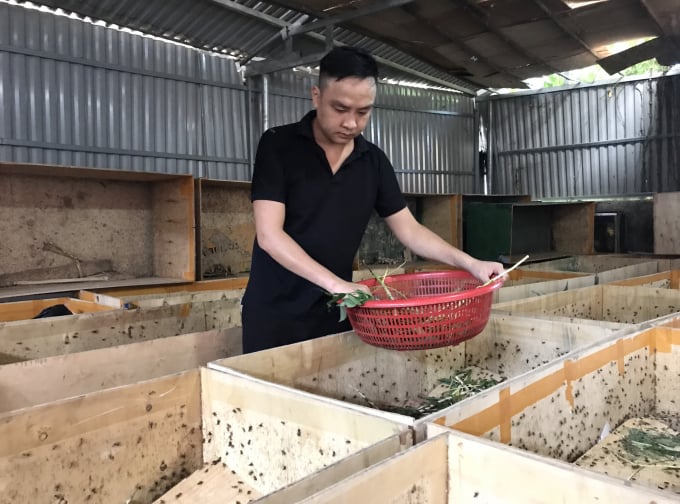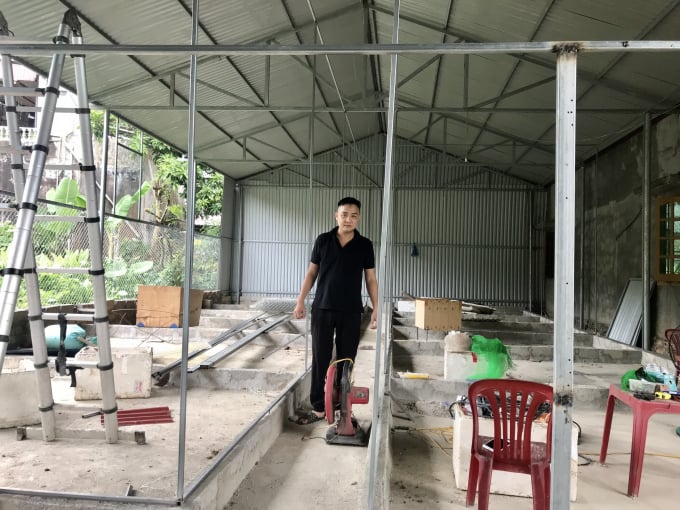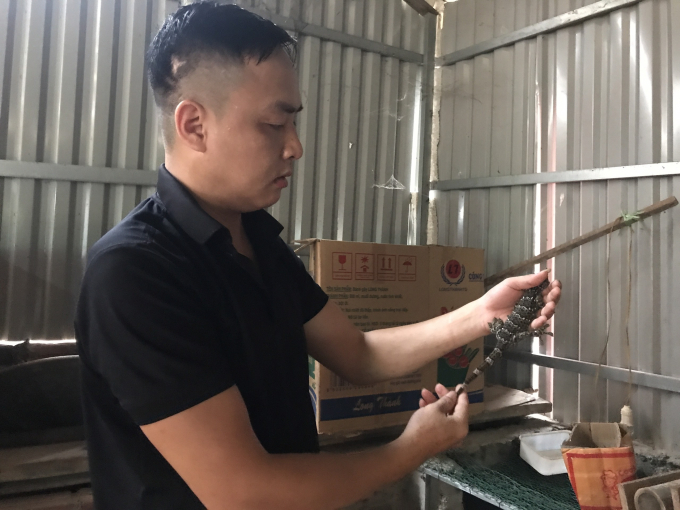November 28, 2025 | 02:31 GMT +7
November 28, 2025 | 02:31 GMT +7
Hotline: 0913.378.918
November 28, 2025 | 02:31 GMT +7
Hotline: 0913.378.918

Trieu Quang Tu is feeding crickets. Photo: Tam Tinh.
In 2015, after two years studying at Viet Bac Art and Culture College in Thai Nguyen City, Trieu Quang Tu graduated. With a hobby of farming, he actively watched a lot of TV programs about crickets farming and read many articles on agricultural extension.
Realizing that cricket farming model could be applied at a farm near his house Tu decided to raising crickets on trial. He contacted and ordered five bags of cricket eggs to hatch in a foam box. After seven days, he had two boxes of baby crickets.
At that time, the cricket farming model had not developed yet in Bac Kan. Tu faced many difficulties in finding documents to raise crickets. At first, he faced failures. When mastering the care and reproduction techniques, Tu turned his family's garden in Bang Lung town, Cho Don District into a 1,000 square meter cricket farm with 100 wooden boxes.
Although he gained initial success he faced challenges in finding market for his products. Tu went to selling points of OCOP product, pubs and customer near and far by himself. In 2019, Tu's facility had a canned cricket product qualified OCOP's three-star standard and being displayed at the stalls in the province.

A corner of the cricket farm of 29-year-old owner Trieu Quang Tu. Photo: Tam Tinh.
Gradually, more and more customers came his farm to buy the product. Few months later, canned cricket product became more and more popular to people in Cho Don District. Not only selling the product at pubs in the province, Tu brought his products to the provinces of Cao Bang, Thai Nguyen and Ha Noi.
Many customers also ordered commercial crickets to feed their birds. Cricket eggs were sold for VND100,000-VND200,000 per tray.
"Crickets are insects living in groups, their food is easy to find. I can grow cassavas or sugarcanes in the garden. Because their life circle is short I can get investment capital quickly. After one month, I harvested 50-60 kilograms of finished crickets earning more than VND10 million. In order to make crickets grow faster, gaining higher yield and quality, avoiding diseases, farmers should pay attention to build higher, cool and clean barns, avoiding windy and rainy sites," 29-year-old owner Trieu Quang Tu said.
Tu added before processing, farmer should leave crickets to go hunger for three days to detoxify toxics from their bodies. After that, crickets are fed with green bean powder then left to go hungry for the next three days. Before storing in the refrigerator, the crickets are cleaned with dilute salt water.

Tu continues to open a gecko farming model, giving guidance to other households in Dong Lac commune, Cho Don distruct, Bac Kan. Photo: Tam Tinh.
In addition to cricket farming, in 2019 Tu continued to open a gecko farming model. So far, he has expanded the model and instructed other households in Dong Lac commnue, Cho Don District to raise this type of reptile. Tu is completing an ornamental bird farming model taking advantage of available crickets, a feed source for birds.
Trieu Quang Tu's cricket farming model is considered as new farming model in locality with stable market and suitable to small-scale farmers because with this model they can take advantage of their leisure time to increase incomes.
/2025/11/27/3830-1-152901_403.jpg)
(VAN) Dong Nai is developing its key crop areas, expanding planting area codes, and applying high technology to increase the value of agricultural products, aiming at a green and sustainable agriculture.

(VAN) Tay Ninh’s livestock sector is undergoing a major transformation, applying high-tech, closed-loop circular models to build sustainable value chains.
/2025/11/26/3627-4-082628_818.jpg)
(VAN) From a small café on the red basalt highlands, Le Van Hoang started a business with clean coffee, building Enjoi Coffee into a symbol of organic agriculture in the Lam Dong plateau.
/2025/11/25/0045-1-135246_13.jpg)
(VAN) Ca Mau is researching a model of sea-encroaching embankments combined with viaducts and logistics service zones, aiming both to prevent erosion and create land funds for marine economic development.

(VAN) The information was shared at the seminar 'Urban Agriculture - Solutions for Developing Green Spaces,' organized by the Kinh te & Do thi Newspaper and the Biotechnology Center of Ho Chi Minh City.
/2025/11/19/4141-2-132831_216.jpg)
(VAN) One of Japfa's outstanding solutions is implementing digital transformation and artificial intelligence (AI) to optimize operations, enhance productivity, and advance sustainable development.
/2025/11/19/4847-1-093540_448.jpg)
(VAN) The Gia Lai Provincial People’s Committee had a working session with the delegation of the U.S. Department of Agriculture, the State of Idaho, and representatives of the State's leading enterprises.